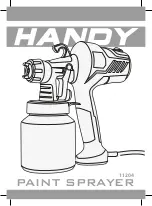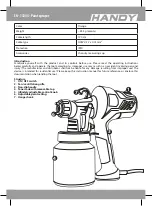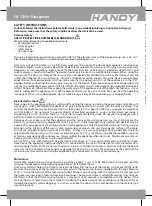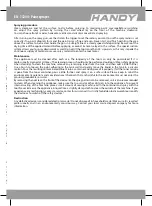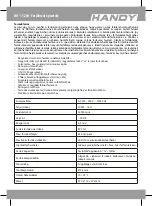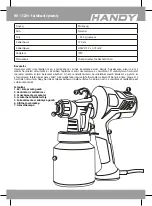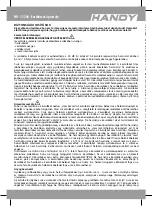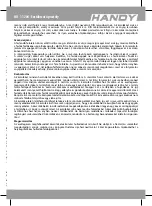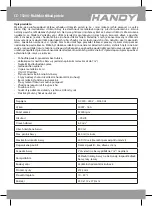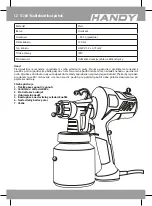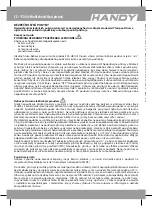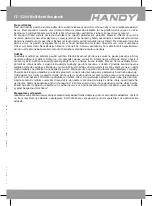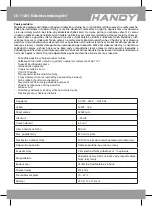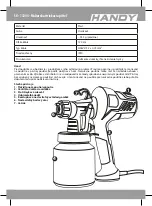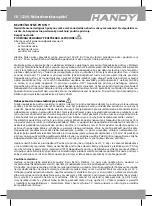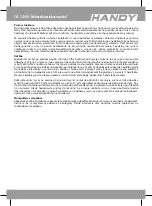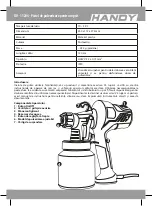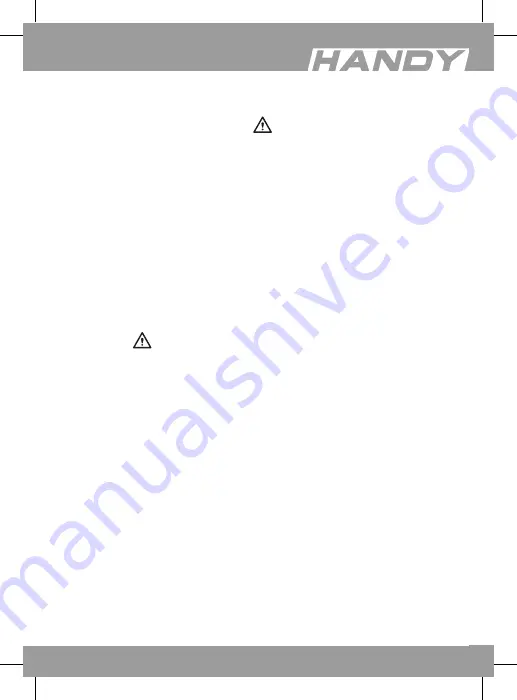
EN - 11204 - Paint sprayer
SAFETY INSTRUCTIONS
Failure to follow the instructions below could result in an accident involving serious personal injury!
Before use, make sure that the safety conditions allow the device to be used.
Personal safety
USE OF PROTECTIVE EQUIPMENT IS MANDATORY!
We recommend wearing to avoid personal injury:
- hearing protection
- safety goggles
- safety gloves
- non slip shoes
The noise level during operation may exceed 90 dB (A)! The vibration level of the device during use is 6.5 m/s².
Please keep these conditions in mind during continuous, prolonged use.
Only carry out painting work in a well-lit, clean work area! Do not use the device near explosive substances or
flammable liquids, gases or dusts! Operation of electrical equipment can cause sparks, which can be extremely
dangerous in such conditions. Wear a mask for the entire duration of painting, as inhalation of paint mist and
solvent vapors is harmful to health. The device should only be used in a well-ventilated room. When using the
tool, ensure the physical safety of those around you. (Especially for children) Do not use the device if you are
under the influence of a mind altering substance (alcohol, medicine, drugs). Using the device requires total
concentration! To avoid accidental start-up, make sure that the power switch (1) of the appliance is in the “OFF”
position before connecting the mains plug! Do not use the device if you experience abnormal operation! Do
not use the appliance if you cannot switch it off with the safety switch. A készüléket gyermekektől elzárva kell
tartani! Danger of suffocation! Please keep the packaging of the appliance out of the reach of children as it may
lead to suffocationThe appliance must not be used by children or by persons who have not read the operating
instructions. When using the appliance, do not smoke in the vicinity of the appliance or use an open flame!
Risk of electric shock
Never operate the appliance with wet, wet hands! Touching the device, including the power plug and cable, with
wet hands is strictly prohibited! The device must only be connected to AC power with the correct voltage. Only
connect the appliance to a mains socket that is safe to operate or has been installed by a specialist in accordance
with IEC 60364-1. Do not point the device directly at electrical equipment, as dust or liquid may get inside it
and damage it. In this situation, there is a risk of short circuit and electric shock. Do not use the appliance near a
bathtub, shower, swimming pool or sink containing water!
Before each use, make sure that the appliance and the mains cable and connectors are intact! Do not use the
device if you have previously dropped or struck it and it is visibly damaged! Only undamaged devices may be
operated! If you experience any damage, do not use the appliance, contact a specialist workshop! During use, pay
attention to the integrity of the mains cable, avoid edges or objects that may damage the surface of the cable.
Do not use plugged-in extension cords or splitters, as they are a source of danger during operation. Use only
splash-proof extension cords with a cross-section of at least 2 x 0.75 mm2. When using the tool outdoors, use only
extension cords designed for outdoor use. Always unplug the appliance when not in use. Maintenance work must
only be carried out with the mains plug disconnected.
Do not fill the tank with detergent! Use the device only above 0 °C to avoid condensation and electric shock.
Never leave the appliance unattended when it is connected to the mains! The device must be protected from
environmental factors (IP20). Do not use the device in rain or in humid environments. Moisture entering the device
increases the risk of electric shock and may damage the device. Do not carry the appliance by the cord, pull the
mains plug by the cord, do not hang the appliance by the mains cord, as this may cause damage.
Material use
Flammable, explosive or corrosive liquids (eg. petrol, alcohol…) must not be filled into the tank and used for
spraying! Do not load material with unknown hazards (safety data sheet).
Only spray material below the viscosity limit can be filled into the tank of the device. Do not overfill the tank!
Measure the viscosity of the material to be sprayed with the measuring funnel supplied with the tool. Measure
at 20 °C! Grasp the bottom of the measuring funnel, fill the measuring cup with the material to be sprayed, and
then measure how long it takes to flow into a container. The measured time is called DIN second. Only material
that flows out of the DIN measuring funnel in a maximum of 40 seconds is compatible with the device. If the
material flows out more slowly, the material is too dense, the device cannot spray and blow out the paint (it may
damage the device’s motor, clogging). In such cases, check the diluent that is compatible with the material you
want to blow out.
Spraying procedure
Clean, degrease and let the surface to dry before spraying to maximize paint coverageBefore switching
on, adjust the spray pattern by turning the scroll wheel (6) on the front of the machine clockwise.
You can choose from 3 modes: horizontal, vertical and circular concentrated spraying.
After turning on the spray gun, use the dial on the trigger to set the radius you want to useThe spray radius is set
correctly if no paint droplets form and the paint spray is fine and even. Never start and finish painting the area
above the surface to be treated. Guide the gun in a straight line at a steady speed while painting. Be aware of the
drying time of the applied material before applying a second, transverse layer to the surface. The special suction
system allows you to spray downwards as well. Do not tilt the tool more than 45° upwards, as this may impede the
continuous supply of material or cause spray material to enter the tool motor.
Maintenance
The appliance must be cleaned after each use. The longevity of the tool can only be guaranteed if it is
professionally cleaned at all times: The cleaning process should only be performed outdoors! Wear safety goggles
when cleaning! To clean the machine, remove any remaining toner from the tank, and then add a little thinner.
Use a brush to loosen the paint adhering to the tank wall and gently move the liquid in the tank in a circular
motion. Pour the resulting contaminated diluent into a container and dispose of it properly. If all the toner residue
is gone from the toner container, pour a little thinner and spray it on a safe surface. Please keep in mind the
environmental regulations and considerations! Chemicals that are harmful to the environment must not enter the
ground, groundwater or water.
By removing the nozzle on the front of the device (6), the spray pattern can be removed, so it is also recommended
to clean. When cleaning the appliance, make sure that no sand or other dirt gets into the appliance. To prevent
internal rusting of the machine, place a small amount of sewing machine oil in the container and spray with the
tool. Never immerse the appliance in liquid! Use a slightly damp cloth to clean the outside of the machine. If you
experience any malfunction, contact a service center for assistance! It is strictly forbidden to disassemble or modify
the device or to switch off the safety devices!
Destruction
Any defective device is considered electronic waste! Do not dispose of in household waste! Make sure it is recycled
professionally and in an environmentally conscious way. Contact your local waste disposal company for more
information.

